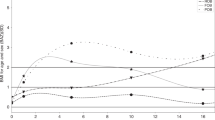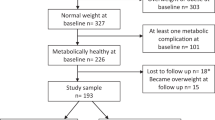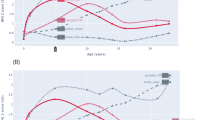Abstract
Objective:
To evaluate how the changes in overweight status from childhood to adolescence are related to metabolic syndrome phenotypes in adolescents.
Subjects and methods:
A total 375 adolescents aged 16 years. The overweight status from childhood to adolescence (from 7 years of age to 16 years) was determined by body mass index (BMI, kg/m2) calculated from records of the School Physical Examination data. The change in body weight was classified into four groups: normal weight to normal weight (NW-NW); overweight to normal (OW-NW); normal to overweight (NW-OW); overweight to overweight (OW-OW). Metabolic syndrome phenotypes were examined from a cross-sectional survey.
Results:
The mean values of all phenotypes except for body fatness (BMI and waist) and the cluster score of phenotypes at 16 years of age were not different between the NW-NW group and the OW-NW group, nor between the NW-OW group and the OW-OW group. However, the score as well as the level of body fatness and blood glucose were significantly different between current overweight and normal adolescents regardless of overweight status during childhood (P<0.05).
Conclusion:
There was a linear relationship between overweight status during childhood and metabolic syndrome phenotypes in adolescence but current overweight status (adolescence overweight) was more closely related to the adolescent risk of metabolic syndrome than childhood overweight status.
This is a preview of subscription content, access via your institution
Access options
Subscribe to this journal
Receive 12 print issues and online access
$259.00 per year
only $21.58 per issue
Buy this article
- Purchase on Springer Link
- Instant access to full article PDF
Prices may be subject to local taxes which are calculated during checkout

Similar content being viewed by others
References
Abraham S, Collins G, Nordsieck M (1971). Relationship of childhood weight status to morbidity in adults. HSMHA Health Rep 86, 273–284.
Colditz GA, Willett WC, Stampfer MJ, Manson JE, Hennekens CH, Arky RA et al. (1990). Weight as a risk factor for clinical diabetes in women. Am J Epidemiol 132, 501–513.
Committee on Health and Statistics (1999). Standard growth charts of Korean children and adolescents in 1998. The board of public health statistics, Korean Pediatric Society.
Cook S, Weitzman M, Auinger P, Nguyen M, Dietz WH (2003). Prevalence of a metabolic syndrome phenotype in adolescents: findings from the third National Health and Nutrition Examination Survey, 1988–1994. Arch Pediatr Adolesc Med 157, 821–827.
de Ferranti SD, Gauvreau K, Ludwig DS, Neufeld EJ, Newburger JW, Rifai N (2004). Prevalence of the metabolic syndrome in American adolescents: findings from the Third National Health and Nutrition Examination Survey. Circulation 110, 2494–2497.
Dietz WH (1994). Critical periods in childhood for the development of obesity. Am J Clin Nutr 59, 955–959.
Duncan GE, Li SM, Zhou XH (2004). Prevalence and trends of a metabolic syndrome phenotype among US Adolescents, 1999–2000. Diabetes Care 27, 2438–2443.
Esmaillzadeh A, Mirmiran P, Azadbakht L, Etemadi A, Azizi F (2006). High prevalence of the metabolic syndrome in Iranian adolescents. Obesity (Silver Spring) 14, 377–382.
Ferraro KF, Thorpe Jr RJ, Wilkinson JA (2003). The life course of severe obesity: does childhood overweight matter? J Gerontol B Psychol Sci Soc Sci 58, S110–S119.
Ford ES (2005). Risks for all-cause mortality, cardiovascular disease, and diabetes associated with the metabolic syndrome: a summary of the evidence. Diabetes Care 28, 1769–1778.
Freedman DS, Kettel Khan L, Serdula MK, Srinivasan SR, Berenson GS (2001a). BMI rebound, childhood height and obesity among adults: the Bogalusa Heart Study. Int J Obes Relat Metab Disord 25, 543–549.
Freedman DS, Khan LK, Dietz WH, Srinivasan SR, Berenson GS (2001b). Relationship of childhood obesity to coronary heart disease risk factors in adulthood: the Bogalusa Heart Study. Pediatrics 108, 712–718.
Himes JH, Bouchard C (1989). Validity of anthropometry in classifying youths as obese. Int J Obes 13, 183–193.
Katzmarzyk PT, Perusse L, Malina RM, Bergeron J, Despres JP, Bouchard C (2001). Stability of indicators of the metabolic syndrome from childhood and adolescence to young adulthood: the Quebec Family Study. J Clin Epidemiol 54, 190–195.
Kim HK (1990). The prevalence of obesity in children and adolescents in Chungbuk and Seoul. Soonchunhyang University: Chungnam.
Kim HM, Park J, Kim HS, Kim DH (2006). Prevalence of the metabolic syndrome in Korean adolescents aged 12–19 years from the Korean National Health and Nutrition Examination Survey 1998 and 2001. Diabetes Res Clin Pract 75, 111–114.
Malina RM, Katzmarzyk PT (1999). Validity of the body mass index as an indicator of the risk and presence of overweight in adolescents. Am J Clin Nutr 70, 131S–136S.
Marshall JD, Hazlett CB, Spady DW, Conger PR, Quinney HA (1991). Validity of convenient indicators of obesity. Hum Biol 63, 137–153.
Mei Z, Grummer-Strawn LM, Pietrobelli A, Goulding A, Goran MI, Dietz WH (2002). Validity of body mass index compared with other body-composition screening indexes for the assessment of body fatness in children and adolescents. Am J Clin Nutr 75, 978–985.
Must A, Jacques PF, Dallal GE, Bajema CJ, Dietz WH (1992). Long-term morbidity and mortality of overweight adolescents. A follow-up of the Harvard Growth Study of 1922 to 1935. N Engl J Med 327, 1350–1355.
Park JH, Son CS, Lee JW, Tocko YC (1993). Obesity in elementary school children. J Korean Pediatr Soc 36, 338–346.
Serdula MK, Ivery D, Coates RJ, Freedman DS, Williamson DF, Byers T (1993). Do obese children become obese adults?A review of the literature. Prev Med 22, 167–177.
Sinaiko AR, Donahue RP, Jacobs Jr DR, Prineas RJ (1999). Relation of weight and rate of increase in weight during childhood and adolescence to body size, blood pressure, fasting insulin, and lipids in young adults. The Minneapolis Children's Blood Pressure Study. Circulation 99, 1471–1476.
Srinivasan SR, Bao W, Wattigney WA, Berenson GS (1996). Adolescent overweight is associated with adult overweight and related multiple cardiovascular risk factors: the Bogalusa Heart Study. Metabolism 45, 235–240.
Srinivasan SR, Myers L, Berenson GS (2001). Rate of change in adiposity and its relationship to concomitant changes in cardiovascular risk variables among biracial (black–white) children and young adults: The Bogalusa Heart Study. Metabolism 50, 299–305.
Sung RY, Tong PC, Yu CW, Lau PW, Mok GT, Yam MC et al. (2003). High prevalence of insulin resistance and metabolic syndrome in overweight/obese preadolescent Hong Kong Chinese children aged 9–12 years. Diabetes Care 26, 250–251.
The National Cholesterol Education Program (NCEP) Expert Panel (2001). Executive Summary of the Third Report of The National Cholesterol Education Program (NCEP) Expert Panel on Detection, Evaluation, And Treatment of High Blood Cholesterol In Adults (Adult Treatment Panel III). JAMA 285, 2486–2497.
Weiss R, Dziura J, Burgert TS, Tamborlane WV, Taksali SE, Yeckel CW et al. (2004). Obesity and the metabolic syndrome in children and adolescents. N Engl J Med 350, 2362–2374.
Willett WC, Manson JE, Stampfer MJ, Colditz GA, Rosner B, Speizer FE et al. (1995). Weight, weight change, and coronary heart disease in women. Risk within the ‘normal’ weight range. JAMA 273, 461–465.
Wilson PW, D'Agostino RB, Parise H, Sullivan L, Meigs JB (2005). Metabolic syndrome as a precursor of cardiovascular disease and type 2 diabetes mellitus. Circulation 112, 3066–3072.
Yoshinaga M, Tanaka S, Shimago A, Sameshima K, Nishi J, Nomura Y et al. (2005). Metabolic syndrome in overweight and obese Japanese children. Obes Res 13, 1135–1140.
Acknowledgements
This study was supported by a research fund from the Hanyang University of Korea (HY-2003).
Author information
Authors and Affiliations
Corresponding author
Rights and permissions
About this article
Cite this article
Kim, K., Kim, M., Shin, Y. et al. Relationship between the change in overweight status from childhood to adolescence and metabolic syndrome phenotypes: a 9-year retrospective study. Eur J Clin Nutr 62, 748–753 (2008). https://doi.org/10.1038/sj.ejcn.1602783
Received:
Revised:
Accepted:
Published:
Issue Date:
DOI: https://doi.org/10.1038/sj.ejcn.1602783



